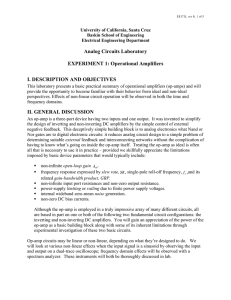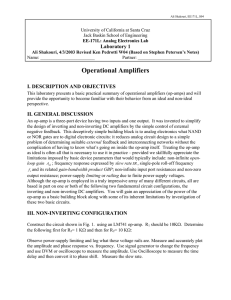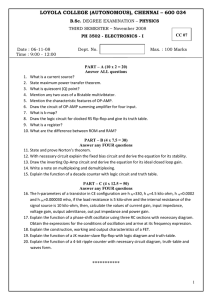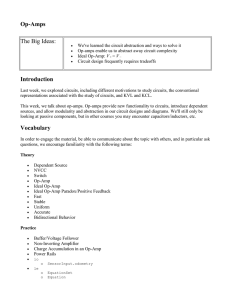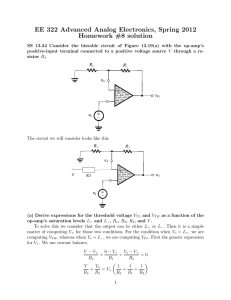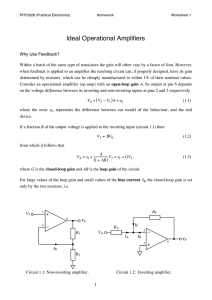Analog Circuits Laboratory EXPERIMENT 1
advertisement
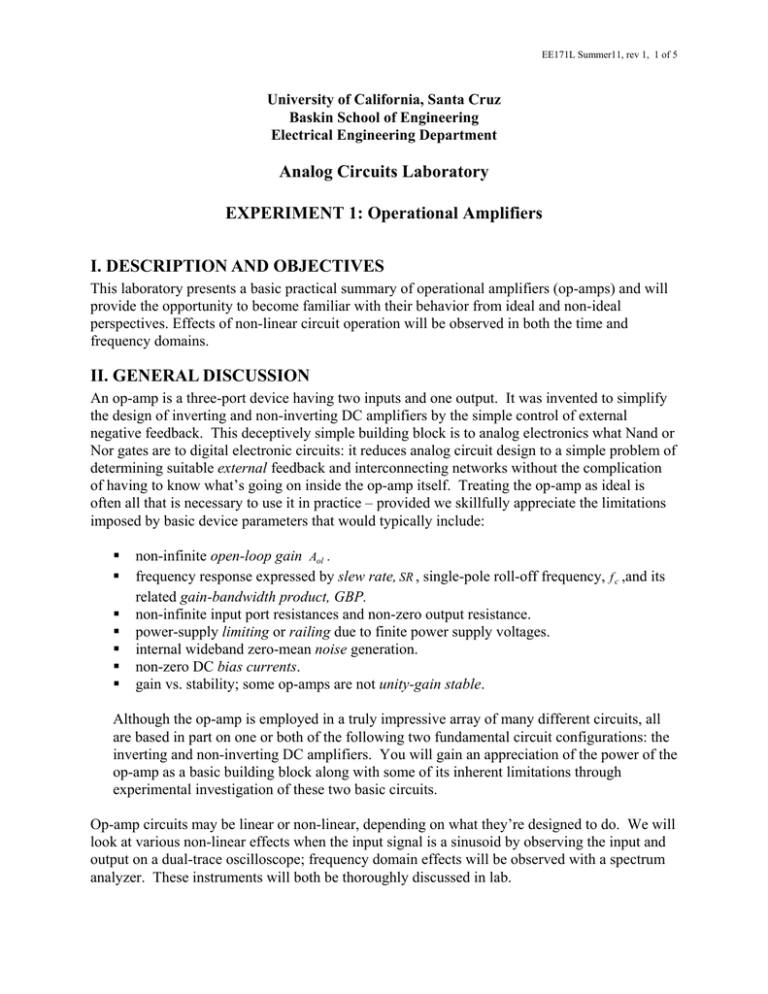
EE171L Summer11, rev 1, 1 of 5 University of California, Santa Cruz Baskin School of Engineering Electrical Engineering Department Analog Circuits Laboratory EXPERIMENT 1: Operational Amplifiers I. DESCRIPTION AND OBJECTIVES This laboratory presents a basic practical summary of operational amplifiers (op-amps) and will provide the opportunity to become familiar with their behavior from ideal and non-ideal perspectives. Effects of non-linear circuit operation will be observed in both the time and frequency domains. II. GENERAL DISCUSSION An op-amp is a three-port device having two inputs and one output. It was invented to simplify the design of inverting and non-inverting DC amplifiers by the simple control of external negative feedback. This deceptively simple building block is to analog electronics what Nand or Nor gates are to digital electronic circuits: it reduces analog circuit design to a simple problem of determining suitable external feedback and interconnecting networks without the complication of having to know what’s going on inside the op-amp itself. Treating the op-amp as ideal is often all that is necessary to use it in practice – provided we skillfully appreciate the limitations imposed by basic device parameters that would typically include: non-infinite open-loop gain Aol . frequency response expressed by slew rate, SR , single-pole roll-off frequency, f c ,and its related gain-bandwidth product, GBP. non-infinite input port resistances and non-zero output resistance. power-supply limiting or railing due to finite power supply voltages. internal wideband zero-mean noise generation. non-zero DC bias currents. gain vs. stability; some op-amps are not unity-gain stable. Although the op-amp is employed in a truly impressive array of many different circuits, all are based in part on one or both of the following two fundamental circuit configurations: the inverting and non-inverting DC amplifiers. You will gain an appreciation of the power of the op-amp as a basic building block along with some of its inherent limitations through experimental investigation of these two basic circuits. Op-amp circuits may be linear or non-linear, depending on what they’re designed to do. We will look at various non-linear effects when the input signal is a sinusoid by observing the input and output on a dual-trace oscilloscope; frequency domain effects will be observed with a spectrum analyzer. These instruments will both be thoroughly discussed in lab. EE171L Summer11, rev 1, 2 of 5 III. NON-INVERTING CONFIGURATION Construct the non-inverting circuit shown in Fig. 1. using an LM324 Quad op-amp. Be sure you understand what every part does before proceeding. R1 should be 10k. Determine the following for R2 = 1k and 10k : Observe power-supply limiting and log what these voltage rails are. Measure and accurately plot the amplitude and phase response vs. frequency. Frequency should be measured with a counter, amplitude in Vrms from a DVM. Measure the slew rate. Observe two types of non-linear behavior: power supply clipping and slew-rate limiting, and note the effects that each of these has separately on an applied sinusoid in both the time and frequency domains. Observe timedomain signals with an oscilloscope and frequency domain signals with a spectrum analyzer. Figure 1. Basic non-inverting op-amp configuration. Note: Re-draw this schematic in your engineering notes and make any experimental scribbles or annotations there. From your linear frequency response data, construct two Bode Plots, one for each of the two different circuit gains. Discuss the meaning of the gain-bandwidth product relationship and verify it from your data. Discuss your results for slew-rate. Numeric data should be discussed with realistic precision using only as many significant figures as your data warrants. Finally, discuss the two types of non-linearity you observed and their consequences. EE171L Summer11, rev 1, 3 of 5 General Recommended Procedure: 1. Don’t mindlessly take data unless you have a good idea of what should be observed. You can analyze things before doing the lab or as you go along. Put everything in your engineering notes. Be sure to accurately measure all resistors before putting them in the circuit. Use the ideal op-amp model to determine the expected closed-loop gains expressing them in both V V and dB. Adjust your DC power sources nominally to + / − 10[V] before connecting them to your circuit. These don’t have to be precise, but accurately measure and log what they actually turn out to be. Use the data sheet to estimate the supply rails and slew-rate. 2. Before taking refined measurements, verify circuit operation by sweeping the signal generator over a 10 or 100:1 frequency range while observing both the input and output simultaneously on the oscilloscope; use dual-trace mode for this. This will give you a good idea of where the cutoff frequency is, whether the circuit is working, and what frequencies to include in your actual measured data. Remember, the cutoff frequency is defined as that frequency where the voltage or power gain has dropped by –3dB and the phase-shift is –45 degrees. Since the gain can more accurately be measured using a DVM, use it rather than time delay to actually find the frequency by observing the AC RMS voltage (this is the only AC voltage that can be measured by the DVM). The observed phase shift on the oscilloscope should be close to –45 degrees in any case. 3. Slew-rate is best measured by changing the input to a square-wave and looking at the output voltage slope over some convenient time interval. Adjust the frequency from the generator to suitably observe this. Be sure the op-amp is not railing. Once you know where slew-rate limiting begins, the effects of this non-linear behavior can also be observed by changing to a sine-wave input. 4. Observe and measure the non-linear effects of clipping (power-supply limiting) using a low sinusoidal frequency to avoid the possibility of slew-rate limiting occurring at the same time. 5. Investigate other phenomena you find interesting if you like and include them in your report. IV. INVERTING CONFIGURATION Modify your circuit to implement an inverting amplifier using the same resistors, and repeat the measurements taken earlier for the non-inverting configuration . Be sure to use one of the other op-amps in the LM324 to remove any effects of the lab generator’s 50 Ohm source impedance from changing the effective gain of your circuit (if you don’t understand this ask the lab staff). Discuss all differences you observe between the non-inverting and inverting configurations. EE171L Summer11, rev 1, 4 of 5 V. QUESTIONS 1. Some op-amps are not unity-gain stable. Investigate and explain what this means. 2. The LM324 is capable of single-supply operation. Explain what this is and show how to use the LM324 as an audio amplifier using a single-supply having a gain of +24dB. This circuit will require the use of blocking capacitors. Explain what they are, why they’re used and what the effects of having them in this circuit are. 3. Is there a relationship between an op-amp’s slew-rate and its frequency response? Explain. 4. When an op-amp is configured to behave as a voltage-follower, its closed-loop gain is 1[V / V ] . Why is this a useful circuit? Can this configuration show gain of any type at all (refer to our textbook, Ch-1)? 5. Your measurement of cutoff frequency assumes a low-pass filter model having only a single dominant pole in its transfer function. Actual op-amps typically have more complicated transfer functions with more poles than this. Why are we justified in using the so-called dominant-pole model ? What would happen to the measured phase shift if the -3dB corner frequency actually was caused by two or more internal poles very close together in frequency? 6. The LM324 is not a “rail-to-rail” op-amp. Investigate what this means and confirm from your data that the LM324 is indeed not a true “rail-to-rail” device. 7. When using a device like the LM324, why are the supply rails bypassed with 100nF capacitors? Adding these bypass capacitors is considered a standard of good engineering practice. Develop a simple theoretical model showing why they are typically necessary and what is being “bypassed.” 8. In Fig. 1 two capacitors appear across the two supply rails. What is their purpose and how should they be physically placed on the actual circuit?

